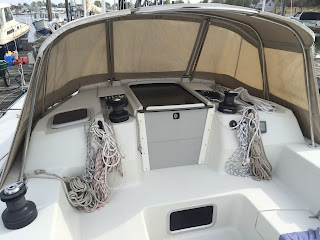Awlgrip the Topsides
The Starboard Side
The Port Side
The Transom
 |
| The Swim Platform |
 |
| Jerry and Chris, The Painters (Thanks Guys) |
Now its time to remove the tape and covering, pull it out of the paint shed, and start to reassembling the boat. This will start with the hatch covers and the rudder.
The Rudder
The rudder has been much more of a major project than I expected when I purchased it. I was told that the manufacturer had manufactured at least one before. But once the yard started to attempt to install the rudder it became apparent that there was still much work to complete on the rudder.
 |
| Rudder in the Box Last Fall |
 |
| Rudder in Initial Condition |
As you can see from the "In the box" picture, the rudder has has beautiful straight stock that is smaller than the steel bearings. The problem is that the connection the rack to the stock on the original rudder is made for a stock that is the same size top to bottom. Therefore, the crew at Milford Boat Works had to add more carbon fiber to get the diameter of the stock to fit the rack. This is shown in the following video (The Rudder in Process) and the following picture, if you look carefully.
The Rudder in Process
Finally, a stainless tube had to be inserted inside the stock and a pin, (that you can see in the following picture and video), to fit the emergency tiller.
 |
| The New and Old Rudders Currently |
Details of the New and Old Rudders
With this work complete, the rudder is ready for installation. My understanding is that this will be completed before Calypso is moved from the paint shed.
Varnishing the Companion Way Components
All sailboat companion ways get a great deal of traffic and more sun than the rest of the boat. Consequently, they get more beaten up, and look it. This was true of Calypso from the time I first saw her.
 |
| One of the Companion Way Boards |
 |
| The Stairs that Attach to the Board |
Shortly, when the weather warms up some more, I will start into varnishing these companion way boards and others in preparation for reassembly. Additionally, I will add a post on implementing a non-skid surface to the stairs (I've been doing some experiments and found something that I really like.
More Soon.







